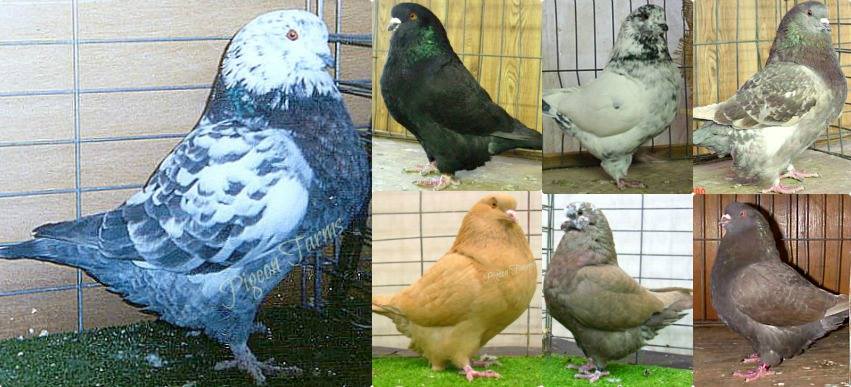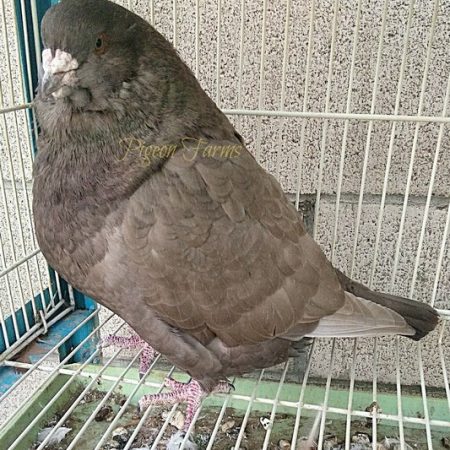Head:
Skull: feathers starting at the wattle shall form a distinctive pompadour blending to a continuous gradual downward arch starting above the eye and at the back of the head rapidly curve into the neck feathers.
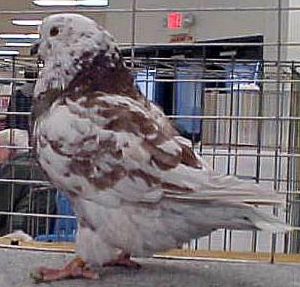
Width of head: 1 1/8″ to 1 1/2″ as measured above the eyes. Depth of head: 2 1/8″ to 2 1/2″ as measured from top of wattle, through lower part of eye, to back of skull feathers.
Beak: short, stout and broad.
Eyes: large and bright but not prominent.
Eye Cere: fine, smooth and narrow.
Neck: shall be full, short and powerful, flowing from back of head without under cut into the smooth continuous back line.
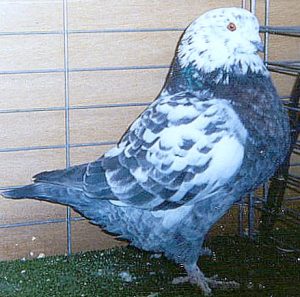
Throat: shall be broad and full with as little undercut from beak into breast line as possible.
Back shall be full and broad when viewed from above and in a wedge shape starting at the shoulders diminish rapidly to the tail.
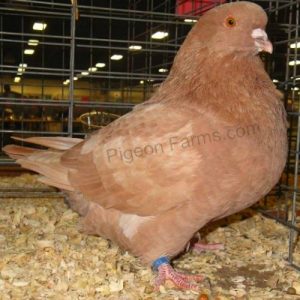 Back shall slope at an angle of 45 degrees when standing in show station with a range not exceeding 5 degrees.
Back shall slope at an angle of 45 degrees when standing in show station with a range not exceeding 5 degrees.
Tail:
Tail width: shall be one feather wide.
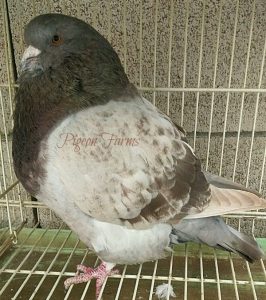
Tail length: shall be 3 3/4″ to 3 7/8″ beyond the body and 7/8″ to 1″ beyond end of flights.
Tail angle: shall be 10 degrees below horizontal.
Wings/Shoulders:
Wing butts: shall be prominent but close to the body and add to the appearance of tremendous width and power. Wings blending into body feathers or being held away from body are undesirable.
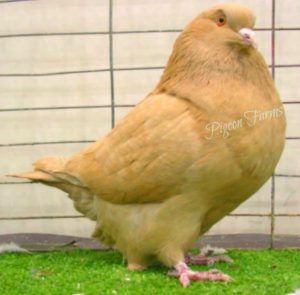
Wing flights: shall be held close to body and lay tightly over rump and tail.
Wing coverts or saddle feathers: shall cover the back and rump, extending as close to the tail as possible for symmetry.
Shoulders: shall be high to add to the square appearance of the bird. Round or droop shoulders are undesirable.
Legs/Toes:
Legs: should be straight when viewed from the front; stout, strong and with well fleshed bulging thighs and drum sticks.

Leg length: shall give the appearance of actual belly clearance from the floor of 2″ by having a shank length of 1 1/8″ to 1 1/4″.
Legs: should be 2 3/4″ to 3 1/8″ apart when in show station. Toes should be short, straight and chubby.
Breast shall be as fully developed and filled out with firm hard flesh as possible.
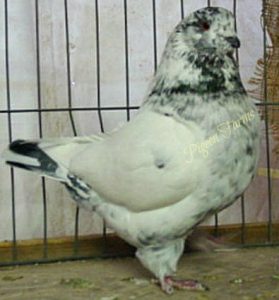
Length of Keel: Keel length shall be about 3 7/8″ to 4″, firm measure or as close as possible to conform to the size of the bird.
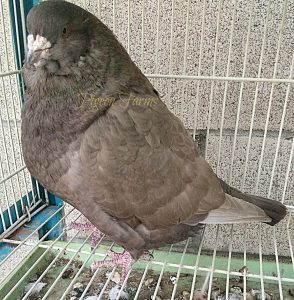
Width of Breast: Breast width shall be equal to keel length by firm measure forward or under wing joint.
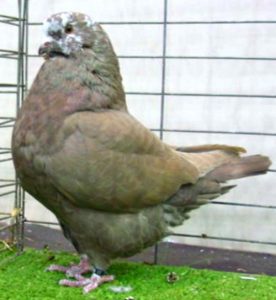
Keel Depth: (5 pts.) Keel or body depth shall be equal to keel length by firm measure at deepest point. Crooked keel – Depending on the severity of the crooked keel, from slight to severe. Slight curvatures will be cut 3 points, while a more pronounced curve will be cut 5 points. An extreme curve will automatically be eliminated early in the class judging.
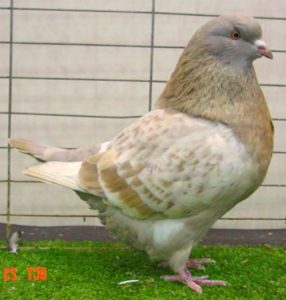
Weight: Birds in the pink of condition.
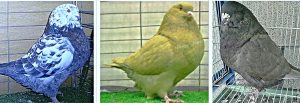
Cock birds: A hard body, 34 to 40 ounces. Hens: A hard body, 30 to 36 ounces.
Final Evaluation: The value of a French Mondain consists of its conformation to the standard of perfection drawings supplemented by its descriptive requirements score.
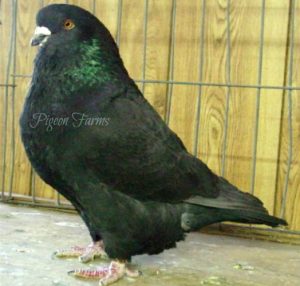
Bird are placed according to value at the moment of judging. Judges decisions are final. No substitution in show entries will be allowed unless they are both color for color and classification. All shows must prominently exhibit the standard of perfection at the time of judging.
Age Classes:
All colors to have standard classes of Old Cock, Old Hen, Young Cock and Young Hen.
Color Classes
CLASS 1 – WHITE White – A pure white feathered bird free from any off colored feathers with bulleyes or bright orange eyes, both eyes shall be the same color, clear flesh colored beak and white toe nails. Pure white birds with dark beaks and toe nai ls shall be shown in the AOC class.
ls shall be shown in the AOC class.
CLASS 2 – INDIGO/ANDALUSIAN Indigo – A steel gray throughout with the neck being a darker shade with a brilliant greenish metallic luster. Wings show two well defined bars in a rust color and tail bar is absent. In checks and T-patterns the checkering shall be a rust color. The beak and toenails shall be black. The eyes a bright orange and eye cere plum to gray. Indigo colored French Mondains shall be shown in spread (barless), check, T-pattern, and bars within the same show class. Andalusian – A steel gray with light and dark shades or black lacing throughout. The neck is a darker shade with a brilliant greenish metallic luster. The head and neck may be black. Andalusian colored French Mondains shall be shown in combination with the Indigo show class.
CLASS 3 – RECESSIVE RED/YELLOW Recessive Red – A rich orange-red or chestnut color over the entire body surface with the richness of color carrying down as near the skin as possible. The beak and toenails shall be flesh colored. Eyes shall be bright orange with red cere. Yellow – A rich deep buff color to a soft light cream color, varying in intensity depending on the pattern with the neck showing a luster or iridescence. May have a frosty iridescent in the neck. Color should be an even tone throughout. The beak and toenails shall be flesh colored to a light horn color. Recessive Red and Yellow colored French Mondains shall be shown within the same class.
CLASS 4 – DILUTE True Silver (Dilute of Blue) – A deep dun color to a light silvery gray color, varying in intensity depending on the pattern. The neck shows a luster or iridescence. Beak and toenails shall be gray to horn colored. Eye cere flesh colored to a grayish white color. When shown in the check pattern the class.
CLASS 5 – BLACK Black – A rich solid jet black color with a brilliant sheen and richness of color carrying down as near the skin as possible, showing no foreign color or ticking. The neck and upper part of the breast are to show a green metallic luster. The beak and toe nails shall be black. Eyes shall be bright orange with plum to gray eye cere. Black colored French Mondains are shown in spread (barless) pattern.
CLASS 6 – BROWN Brown – A light to medium brown with a base ground color of chocolate sometimes referred to as chocolate or coco. The beak and toenails shall be horn colored; eyes shall be pearl, with beet red to red eye cere. No white or off-color feathers anywhere. When shown in the check pattern the checks shall be very dark brown. The intensity of pattern may vary from a modest amount to a very dense concentration. The neck and head may be of the same brown color with an iridescent green and purple. When shown in the bar pattern, the brown shade should remain uniform throughout the wing shields, with the bars being dark brown becoming almost coco. The head and neck are most often a darker shade, showing the iridescence of green and purple. The bars, two in number, should be coco. When shown in the spread or barless pattern, the color shall be a rich chocolate or cocoa over he entire surface with color carrying down as near as the skin as possible. This shade should remain uniform throughout the wing shields, back, rump, hocks and vent. The neck showing a luster or iridescent that is noticeable as a green Color should be an even tone throughout. Brown colored French Mondains shall be shown in checks, T-pattern, bars, and spread (barless) patterns within the same class.
CLASS 7 – BLUE Blue – A medium to dark blue with a base ground color of light blue sometimes referred to as powder blue or sky blue. The beak and toenails very from dark to almost black. Eyes shall be bright orange with plum to gray colored eye cere. No white or off-color feathers shall appear anywhere.
CLASS 8 – ASH RED Ash Red – A rich even shade of ash-gray that has light pale ash under color. Beaks and toenails will vary from very dark to medium horn color and some cases so light it’s almost white. Eyes shall be bright orange with gray eye cere. No white or off-color feathers shall appear anywhere on the body. When shown in the check pattern the checks may vary in color from a soft pale shade of brownish red to a dark red approximately the color of a new brick. The intensity of pattern may vary from a modest amount to a very dense concentration. The neck and head may be of the same ash-gray color with an iridescent green and purple, with green color predominating. When shown in the bar pattern, the ash-red shade should remain uniform throughout the wing shields, back, rump, hocks and vent. The head and neck are most often a darker shade. The neck showing the iridescent green and purple, with green predominate. The flight feathers are dark brownish red becoming almost coco on the outer edges and tips. The tail should have a dark brown band. The bars, two in number, should be coco. When shown in the spread or barless pattern, the color can vary from a dull red to steel gray over the entire surface with color carrying down as near as the skin as possible. This shade should remain uniform throughout the wing shields, back, rump, hocks and vent. The neck showing a luster or iridescent that is noticeable as a green iridescent. Color should be an even tone throughout Ash Red colored French Mondains shall be shown in spread (barless), checks, T-pattern, and bars within the same class.
CLASS 9 – A.O.C. AOC – A literal translation of “any other color”. This class is intended to include anything that does not fit into any of the nine classes previously listed. The AOC class includes, but is not limited to, colored birds showing one or more white feathers, smutty recessive reds and yellows, bars and checks not showing proper pattern, whites with dark beaks or toenails, etc. Pure white birds with dark beaks and or dark colored toe nails shall be shown in the AOC class.
CLASS 10 – RARE Rare – All reduced, almond and faded, regardless of color pattern, all barred and barless regardless of color, not covered in other standard color classes. All foregoing to be free of stray white feathers. Other colors and patterns admissible to this class as they may occur: these may include but not limited to recessive opal, powder blue, milky, whiteside, saddle, pale, toy stencil, bronze, and etc. Show Secretaries and/or their representatives shall determine the admissibility into color class at each show.
CLASS 11 – DOMINANT OPAL Dominant Opal – Dominant Opal is a dominant genetic modifying factor that can be placed on any color or pattern. Generally the underlying pattern will show through and the expression varies from almost undetectable to white in places that are normally black in a blue pigeon. Generally the dark spots such as bars and checks are lightened, often they become either a tan or white color. The factor generally lightens the color, replacing the iridescent green in the neck and breast with a yellowish cast. In ash red, it often can be a very light expression. Color should be an even tone throughout. Two well defined wing bars in check and bar pattern. Beak and toenails black to gray in blue colored birds and horn to flesh colored in red birds. All toenails the same color with the eye cere being a grayish color. Dominant Opal colored French Mondains shall be shown in spread (barless), checks, T-pattern, and bar patterns within the same class.
CLASS 12 – ALMOND Almond – Basically whitish-sandy with some bronzing and black or other dark mottling (break) especially prominent in cocks and increasing with age. The ground color to be deep, rich, sound yellow. Rump and thighs the same color as shoulders, evenly spangled with black. The flights and tail feathers should show three distinct colors; yellow, black and white which should be in patches and clearly defined. Beak should be flesh colored.
CLASS 13 – PIED/SPLASH Pied/Splash – A multi colored bird composed of patchwork pattern of white and any other colored feathers. Colors being in splotches, and have 30% or more white and 30% or more of some other solid color. Flecked, spotted, grizzled and similar colored birds will not be shown in this class. The colored and white areas should be contrasting without regularity or symmetrical pattern. This appearance is typically seen in black and white birds, but is also seen in recessive red/yellow and white, ash and white, solid brown and white, dun and white, and andulusian and white combinations.
